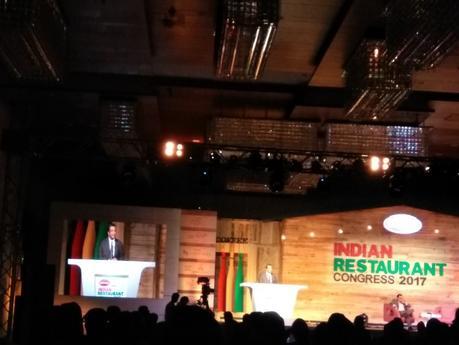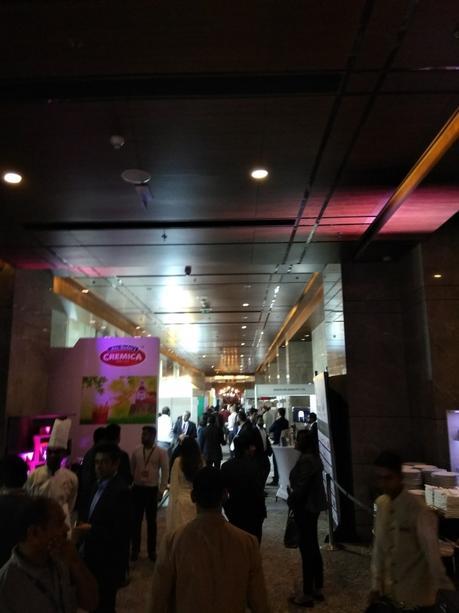Indian Restaurant Congress this year has a prime focus on growth targets of restaurant sector in India. It is quite evident that the sector is growing at a high pace. The credit for this goes to the middle class of India. There are more than 300 million people in the middle class. The credit of growth of F&B industry at the rate of 15-20% goes to this segment of our society. And it is pacing up fast. Which means that within a span of every 4-5 years, it doubles up. That is a phenomenal growth. But as we know every growth brings a lot of challenges and risks. Total food market size in India in 2016 was Rs. 309,110 crore or USD 48 billion. Growing at a CAGR of 10% it will be touching Rs. 498,130 crore or USD 77 billion by 2021.

The inaugural session Indian Restaurant Congress had two prominent personalities from F&B industry but from parallel segments. While Zorawar of Massive Restaurants was representing the food segment, Srivatsa Krishna from Coffee Board of India was representing the Coffee segment. The quality and perception are changing rapidly in both the segments. In India, the ratio of coffee to tea consumption is 1:16. It means for every single coffee cup consumer there are 16 tea consumers. And the same ratio widens drastically if we talk about North India. It falls to 1:60. That is against every 60 cups of consumption of tea, there is a single coffee consumption.
Indian Restaurant Congress Focuses on Quality and Technology
The story of Coffe is quite interesting when it comes to India. While the production cost of coffee is around Rs. 250-300 per kg, its selling cost goes as high as Rs. 3000 per kg. That is exorbitant if you compare it with any other food product. Similarly, a cup costs from Rs. 25 to Rs. 300 for the same quality of coffee depending on the brand and outlet selling it. 225,000 coffee machines have been installed in last decade. There is another angle to coffee that might be intriguing for health conscious people who consume coffee. Chicory is 100% carbohydrate and it costs just Rs. 60 per kg. Most of the prestigious coffee stores mix upto 49% of chicory in coffee to brings its cost down and raising their profits without any cut in selling price. That is where pure filter coffee comes into the picture.

That way India is a tea country. Coffee Board of India plans to transform it into Coffee country. As we know India is the 5th largest producer of coffee in the world. But most of our coffee is exported as consumption in India is minuscule. “Our vision is to create a pure Indian filter coffee. By next year, we will have modern, clean, cool and affordable Coffee Houses across India offering Indian filter coffee and snacks. Till now, India has been a tea country, my objective is to also make it coffee country,” says Srivatsa Krishna, CEO & Secretary, Coffee Board of India said at Indian Restaurant Congress 2017 in New Delhi.
Indian Restaurant Congress talks about experiential dining
Zorawar Kalra, Founder and Managing Director, Massive Restaurants which owns Farzi Cafe, Conference Chairperson for the Indian Restaurant Congress 2017 says, “We are an important industry in India. Indian restaurant market is 40 times of Bollywood. Indian food industry is producing 2 per cent of Indian GDP and is the second largest employer of human capital in India after agriculture. As the Indian middle class is now spending more and more, food sector will automatically receive larger share out of their spending”.
There are celebrity chefs, restaurateurs, and industry leaders including Celebrity Chef Ranveer Brar, Unnat Varma (MD, Pizza Hut- India Subcontinent), Ashish Kapur (Founder & Director, Moods Hospitality Pvt. Ltd.), Sameer Bhasin (CEO, Barbeque Nation), Varun Tuli (Director, Yum Yum Cha) attending the event.
“Today consumers who are drawn to an experiential dining experience are willing to pay more, too. Indian Restaurant Congress 2017 will share the building blocks of the food service in an innovative ecosystem. It is the platform where restaurants, chefs, brands would find future business models and ideas to address tomorrow’s market demand”, says Ritu Marya, Director and Conference Convener, Franchise India.
If we talk about the popularity of various cuisines in India, North Indian cuisine is the more preferred standing at 28%. Next are Chinese at 19% and South Indian at 9%. Many Indian restaurants and F&B groups are expanding to global markets in the fine dining spectrum. That concludes the first day of Indian Restaurant Congress 2017 in J W Marriot, Aerocity, New Delhi.
